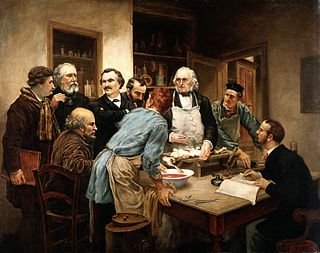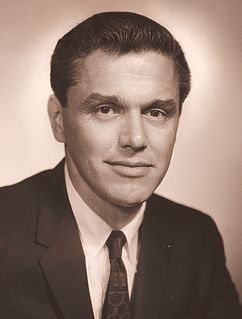
Physiology is the scientific study of functions and mechanisms in a living system. As a sub-discipline of biology, physiology focuses on how organisms, organ systems, individual organs, cells, and biomolecules carry out the chemical and physical functions in a living system. According to the classes of organisms, the field can be divided into medical physiology, animal physiology, plant physiology, cell physiology, and comparative physiology.

Sir Frederick Gowland Hopkins was an English biochemist who was awarded the Nobel Prize in Physiology or Medicine in 1929, with Christiaan Eijkman, for the discovery of vitamins, even though Casimir Funk, a Polish biochemist, is widely credited with discovering vitamins. He also discovered the amino acid tryptophan, in 1901. He was President of the Royal Society from 1930 to 1935.
Neuropsychiatry is a branch of medicine that deals with mental disorders attributable to diseases of the nervous system. It preceded the current disciplines of psychiatry and neurology, which had common training, however, psychiatry and neurology have subsequently split apart and are typically practiced separately. Nevertheless, neuropsychiatry has become a growing subspecialty of psychiatry and it is also closely related to the fields of neuropsychology and behavioral neurology.

Wolfgang Rindler was a physicist working in the field of General Relativity where he is known for introducing the term "event horizon", Rindler coordinates, and for popularizing the use of spinors in general relativity. An honorary member of the Austrian Academy of Sciences and foreign member of the Accademia delle Scienze di Torino, he was also a prolific textbook author.
Rubicon Foundation, Inc. is a non-profit organization devoted to contributing to the interdependent dynamic between research, exploration, science and education. The foundation, started in 2002, is located in Durham, North Carolina and is primarily supported by donations and grants. Funding has included the Office of Naval Research from 2008 to 2010. Gibson, Dunn & Crutcher has provided pro bono services to assist in copyright searches and support.

Evolutionary physiology is the study of the biological evolution of physiological structures and processes; that is, the manner in which the functional characteristics of individuals in a population of organisms have responded to natural selection across multiple generations during the history of the population. It is a sub-discipline of both physiology and evolutionary biology. Practitioners in the field come from a variety of backgrounds, including physiology, evolutionary biology, ecology, and genetics.

Solute carrier family 22 member 8, or organic anion transporter 3 (OAT3), is a protein that in humans is encoded by the SLC22A8 gene.
The Botanical Society of America (BSA) represents professional and amateur botanists, researchers, educators and students in over 80 countries of the world. It functions as a United States nonprofit 501(c)(3) membership society.

The Association for Applied Psychophysiology and Biofeedback (AAPB) was founded in 1969 as the Biofeedback Research Society (BRS). The association aims to promote understanding of biofeedback and advance the methods used in this practice. AAPB is a non-profit organization as defined in Section 501(c)(6) of the Internal Revenue Service Code.

Xanomeline (LY-246,708; Lumeron, Memcor) is a muscarinic acetylcholine receptor agonist with reasonable selectivity for the M1 and M4 subtypes, though it is also known to act as a M5 receptor antagonist. It has been studied for the treatment of both Alzheimer's disease and schizophrenia, particularly the cognitive and negative symptoms, although gastrointestinal side effects led to a high drop-out rate in clinical trials. Despite this, xanomeline has been shown to have reasonable efficacy for the treatment of schizophrenia symptoms, and one recent human study found robust improvements in verbal learning and short-term memory associated with xanomeline treatment.
Physiological Reviews is a journal published quarterly by the American Physiological Society which has been published since 1921. The editor in chief of the journal is Sadis Matalon. The journal's first managing editor, who served to his death in 1946, was Dr. Donald R. Hooker. Among the cadre of editors at the journal's inception were William Henry Howell, Lafayette Mendel, and John Macleod. From 1932 to 1950, the chairman of the board of editors of the journal was Anton J. Carlson. Other notable people who have served on the journal's editorial board include John Jacob Abel (c.1935), Ernest William Goodpasture (c.1938).
The American Physiological Society was founded in 1887 with 28 members. Of them, 21 were graduates of medical schools, but only 12 had studied in institutions that had a professor of physiology. Today, it has 10,500 members, most of whom hold doctoral degrees in medicine, physiology or other health professions. Its mission then, as now, is to support research, education, and circulation of information in the physiological sciences.

Robert Kellogg Crane was an American biochemist best known for his discovery of sodium-glucose cotransport.
The American Society of Plant Biologists (ASPB) is a professional society devoted to the advancement of the plant sciences. It was founded in 1924 as the American Society of Plant Physiologists and renamed in 2001. It publishes The Plant Cell, Plant Physiology, and Plant Direct. The ASPB organizes conferences and other activities that are key to the advancement of science.
The Journal of Applied Physiology is a monthly peer-reviewed medical journal of physiology published by the American Physiological Society. The journal was established in 1948, and is currently edited by Sue Bodine. According to the Journal Citation Reports, the journal has a 2014 impact factor of 3.056.
Wallace Osgood Fenn was a prominent physiologist, chairman of the department of physiology at the University of Rochester from 1925 to 1959. He also headed the University's Space and Science center from 1964 to 1966. He was also the president of the American Physiological Society, the president of the American Institute of Biological Sciences, and the president of the International Union of Physiological Science. His work on heat generated by muscles, oxygen use by the nervous system, and potassium equilibrium in muscle, as well as pressure breathing and nitrogen narcosis, was recognized internationally. The New York Times called him a "leading physiologist". Other recognitions included: honorary degrees from the University of Chicago, the University of Brussels and from the University of Paris, as well as the following awards: Feltrinell International Prize for Experimental Medicine and the Guggenheim award of the International Academy of Astronautics.
Comprehensive Physiology is a peer-reviewed scientific journal published by John Wiley & Sons on behalf of the American Physiological Society.

Lloyd Alexander Jeffress was an acoustical scientist, a professor of Experimental Psychology at the University of Texas at Austin, a developer of mine-hunting models for the US Navy during World War II and after, and the man Nobel Laureate Linus Pauling credited with getting him interested in chemistry.








